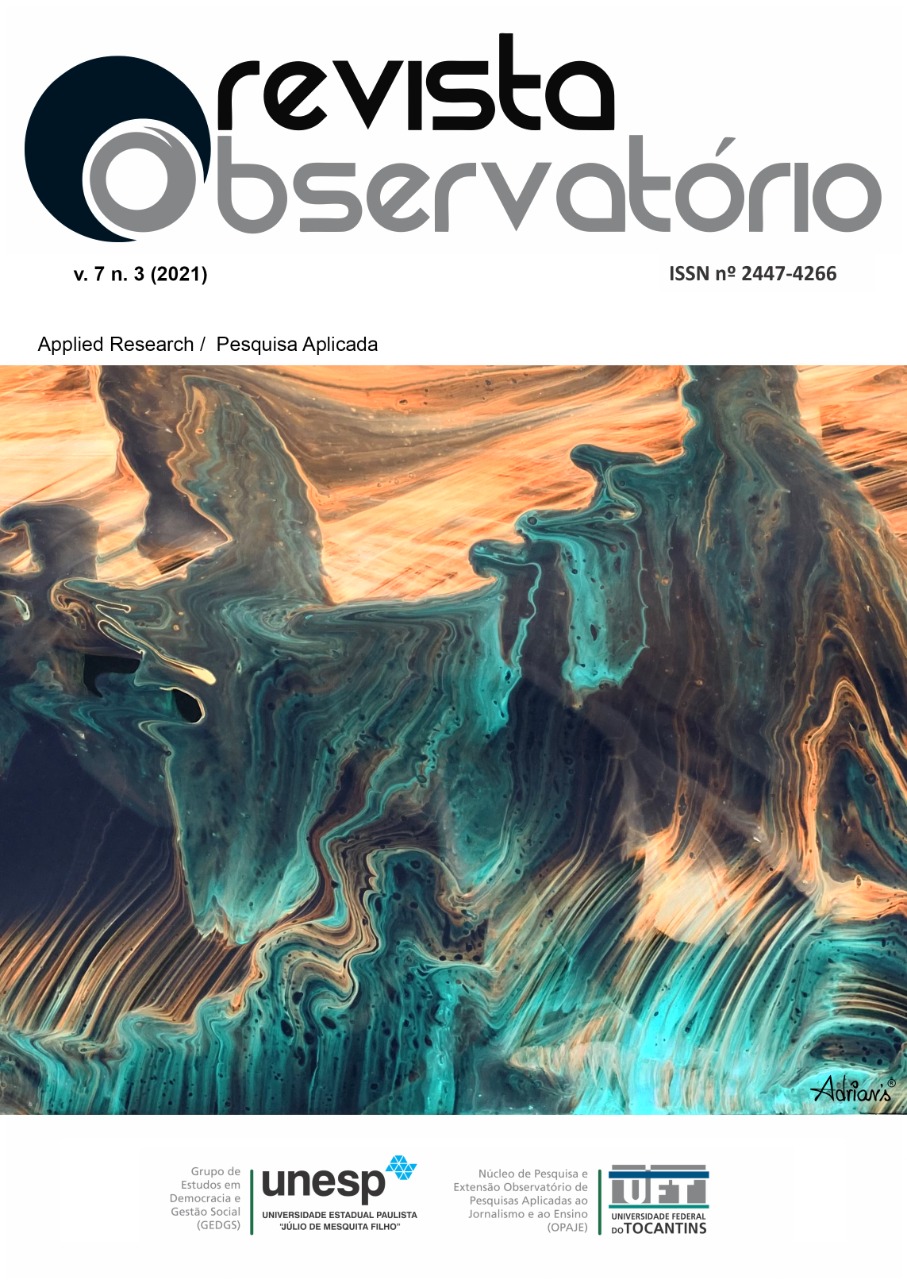SOCIAL NETWORK ANALYSIS TECHNIQUES (SNA): an applied research method to investigate the role of the Canadian Ministry of Health in combating COVID-19
DOI:
https://doi.org/10.20873/uft.2447-4266.2021v7n3a7enKeywords:
Communication, Higher Education, Advertising, Government AdvertisingAbstract
In this study we present a proposal for digital methods using Social Network Analysis (ARS) techniques as a product that materializes in ways to investigate data from social networks. Through such methods, we research the potential of these techniques to investigate the topology of networks and the individual and collective actions of their actors. As an example, we adopted as a case study the Twitter profile of the Ministry of Health of Canada to examine actors and communication strategies in combating the pandemic. These actors played a leading role in distributing information against Covid-19. As a contribution, we identified that, through the methods adopted, it was possible to perceive a triangulation in the communication of government agents with their public, in addition to identifying communication strategies in combating the pandemic.
Downloads
References
AHMED, Wasim; VIDAL-ALABALL, Josep; LÓPEZ SEGUÍ, Francesc; MORENO-SÁNCHEZ, Pedro A. A social network analysis of tweets related to masks during the COVID-19 pandemic. Int. J. Environ. Res. Public Health, v. 17, n. 21, 2020.
ARNABOLDI, V.; CONTI, M.; PASSARELLA, A.; DUNBAR, R. I. M. Online social networks and information diffusion: the role of ego networks. Online Social Networks and Media, v. 1, p. 44-55, 2017. DOI 10.1016/j.osnem.2017.04.001
GABARDO, A. D. Análise de redes sociais: uma visão computacional. São Paulo: Novatec, 2015.
GOLDBERG, Marco Cesar. Grafos: conceitos, algoritmos e aplicações. Rio de Janeiro: Elsevier, 2012.
GRUZD, A.; MAI, P. Inoculating against an infodemic: a Canada-wide COVID-19 news, social media, and misinformation survey. Ryerson University Social Media Lab, 2020. DOI 10.5683/SP2/JLULYA.
GRUZD, A. Netlytic: software for automated text and social network analysis. 2016.
GRUZD, A. (2016). Netlytic: Software for Automated Text and Social Network Analysis. Available at http://Netlytic.org
GUISSONI, Leandro Angotti. Proposta de um método para a análise dos efeitos das atividades de marketing e alocação de recursos em um ambiente multicanal. 2012. Tese (Doutorado em Administração de Organizações) - Faculdade de Economia, Administração e Contabilidade de Ribeirão Preto, Universidade de São Paulo, Ribeirão Preto, 2012. doi:10.11606/T.96.2012.tde-13122012-102644. Acesso em: 2021-06-29.
KHAN, Gohar Feroz; YOON, Ho Young; PARK, Han Woo. Social media communication strategies of government agencies: Twitter use in Korea and the USA. Asian Journal of Communication, v. 24, n. 1, p. 60-78, 2014. DOI 10.1080/01292986.2013.851723.
LEMIEUX, V.; OUIMET, M. Análise estrutural das redes sociais. Lisboa: Instituto Piaget, 2004.
MENCZER, F.; FORTUNATO, S.; DAVIS, C. A first course in network science. Cambridge: Cambridge University Press, 2020. DOI 10.1017/9781108653947.
MERGEL, I. Social media adoption and resulting tactics in the U.S. federal government. Government Information Quarterly, v. 30, n. 2, p. 123-130, 2013.
MOSSBERGER, Karen; WU, Yonghon; CRAWFORD, Jared. Connecting citizens and local governments? Social media and interactivity in major U.S. cities. Government Information Quarterly, v. 30, n. 4, 2013.
NEWMAN, N.; FLETCHER, R.; SCHULZ, A.; ANDI, S.; NIELSEN, R. Reuters Institute Digital News Report. Oxford: Reuters Institute, 2020. Disponível em: https://www.digitalnewsreport.org. Acesso em: 10 mar. 2021.
LUTU, Patricia E. Nalwoga. Using Twitter mentions and a graph database to analyse social Network Centrality. In: INTERNATIONAL CONFERENCE ON SOFT COMPUTING & MACHINE INTELLIGENCE (ISCMI), 6., 2019. p. 155-159. Doi: 10.1109/ISCMI47871.2019.9004313.
OMENA J. J. (ed.). Métodos digitais: teoria‐prática‐crítica. Lisboa: ICNOVA, 2019. (Coleção Livros ICNOVA).
PAULINO, R. C. R.; EMPINOTTI, M. L.; VENTURA, M. P. Antagonismo e engajamento revelados nas mídias sociais: análise das hashtags #Somos70porcento e #FechadoComBolsonaroAte2016. In: ENCONTRO NACIONAL DE PESQUISADORES EM JORNALISMO, 18., 2020, São Paulo. Anais [...]. São Paulo: SBPJOR, 2020.
RECUERO, Raquel; GRUZD, Anatoliy. Cascatas de fake news políticas: um estudo de caso no Twitter. Galáxia, n. 41, p. 31-47, 2019.
RECUERO, R.; SOARES, F. O discurso desinformativo sobre a cura do COVID-19 no Twitter: estudo de caso. E-Compós, 2020. DOI https://doi.org/10.30962/ec.2127.
RECUERO, Raquel, BASTOS, Marco, ZAGO Gabriela. Análise de redes para mídia social. Porto Alegre: Sulina, 2015.
SPERBER, D., Le structuralisme em anthropologie, em O. Ducrot (dir.), Paris: Seuil, 167-238.
SLOAN, L., & QUAN-HAASE, A. (2016). The SAGE Handbook of social media research methods. SAGE Publications Ltd https://www.doi.org/10.4135/9781473983847
STOKMAN, N. Frans. Networks: Social. International Encyclopedia of the Social & Behavioral Science N.J. Smelser an P.B. Baltes. Oxford: Elsevier Science, 2001.
VENTURINI, T.; JACOMY, M.; BOUNEGRU, L.; GRAY, J. Exploração visual de redes para jornalistas de dados 99. In: OMENA J. J. (org.). Métodos digitais: teoria‐prática‐crítica. Lisboa: ICNOVA, 2019.
ZEEMERING, Eric S. Functional fragmentation in city hall and Twitter communication during the COVID-19 pandemic: evidence from Atlanta, San Francisco, and Washington, DC. Government Information Quarterly, v. 38, n. 1, 2021.
Published
How to Cite
Issue
Section
License
[PT] Autores que publicam nesta revista concordam com os seguintes termos:
1. Autores mantém os direitos autorais e concedem à revista, sem pagamento, o direito de primeira publicação, com o trabalho simultaneamente licenciado sob a Creative Commons Attribution License (CC BY-NC 4.0), permitindo o compartilhamento do trabalho com reconhecimento da autoria do trabalho e publicação inicial nesta revista.
Leia todos os termos dos direitos autorais aqui.

